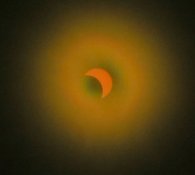TLDR: Just get the darn eclipse glasses, from a reliable source.
In the Bad Old Days we sometimes used totally fogged and developed silver black and white film to observe solar eclipses. Like a throughly exposed and developed 35mm leader. Official sources will not recommend this now. Ideally, you should use eclipse glasses purchased from a reliable source (not a random anonymous seller on amazon or ebay), or solar filter film purchased from a reliable source (like Baader or Astro-Physics). These are tested to be effective. If you do take it upon yourself to use a fogged developed film leader, just look for a few seconds, don't stare at the sun for minutes like an idiot.
Under no circumstances should you use something like an R72 filter. The whole point of the fogged film or official solar filter is that the metallic film blocks infrared.
Reasons that official sources endorse eclipse glasses and not fogged developed B&W film include that:
- eclipse glasses are easier to get now, if you order ahead,
- people confuse color and B&W film (undeveloped color film does not have enough silver, and developed color film doesn't have any),
- people confuse silver B&W film and chromogenic B&W like XP2, which has no silver when developed,
- no official source knows your film type or developing practices or whatever and can test or guarantee the opacity of your film leader, even if you are actually using a real B&W film.
Before the 2012 (annular) and 2017 solar eclipses, I tried out a few undeveloped and developed pieces of silver B&W film, observing bright lights and scanning across the sun, and my memory is that the opacity varied a lot, which is not reassuring. In particular, I think undeveloped B&W film (silver halide, not metallic silver) was not opaque enough visually, which suggests worse in the infrared. I got the official solar filter material from Baader and made a filter to go over binoculars.
I've made pinhole cameras to view solar eclipses. It's not trivial because the angular diameter of the sun is small. I used a cardboard box for skis, about 6 feet long. This still makes only about a 15mm diameter solar image. With a maybe 0.5mm pinhole, you have a camera of about f/3600. The sun is bright, but you still need to shade the viewing screen from ambient light (less so during totality).








 Eclipse-1327
Eclipse-1327
